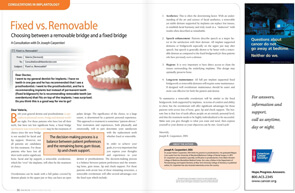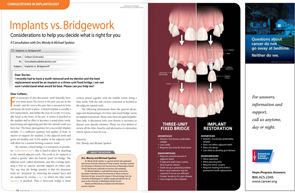Bridges
Fixed bridges (also called fixed partial dentures) are used to replace missing teeth and gum tissue.They are attached to neighboring teeth and cemented into place. The underlying substructure can be made of a ceramic material or metal, but the restorations are typically porcelain.
A fixed bridge right for me?
Generally speaking, if you're missing a tooth or teeth, and if you have sufficient bone, dental implants are most often the best choice. However, a fixed bridge may be the best option if you:
- Have economic or health reasons that prevent you from getting implants
- Want an option that usually lasts longer and looks and feels better than a removable appliance
- Don't mind having adjacent teeth crowned to serve as an anchor
Porcelain can be bonded to a precious or nonprecious metal. Although precious metals such as gold are generally more expensive, some nonprecious metals can tarnish, leaving a slightly dark line near the gum tissue if the porcelain does not fully encase the metal. Zirconia or other very hard tooth-colored ceramic may be used instead to provide more trnslucency and naturalness. These new all-ceramic bridges offer more strength and improved esthetics.
Bridges will change the way you floss
It's important to remember that the teeth be replaced and used to support the bridge will be joined. This means you will no longer be able floss through the contacts between the teeth. Instead, you will need a floss threader, which will allow you to floss under the missing tooth or teeth as well as between the teeth.
Advantages:
- Long lasting
- Easy to dean
- Can improve your bite
- Helps prevent movement of adjacent and opposing teeth
Disadvantages:
- Costs more than removable bridge
- More tooth reduction than cantilever or resin-bonded bridge
- May be more difficult to achieve natural look in cases of bone or gum loss
A beautiful esthetic result can be achieved with a conventional fixed bridge because the teeth needed to anchor the bridge on either side of the missing teeth are made into crowns and no metal shows. However, there must be sufficient room for porcelain between the upper and lower teeth when replacing a missing tooth with a fixed bridge. If necessary, either a crown-lengthening surgical procedure or orthodontic treatment can usually help create the needed space.
What is a cantilever fixed bridge?
A cantilever fixed bridge is attached on only one side and therefore is an option when there is not an anchor tooth available on both sides of a tooth to be replaced. The cantilever fixed bridge may be considered a more conservative treatment than a conventional bridge because fewer teeth are reduced, and the esthetic result can be as good or better. It is also less expensive than a conventional bridge; however, its life expectancy is usually not as long.
Advantages
- Less tooth structure reduced
- Less expensive than conventional bridge
- More natural separation possible between teeth
Disadvantages
- Less structural support
- Unless the bite is perfectly balanced, too much torque can damage the replacement tooth
Another type of fixed bridge is the resin-bonded bridge, also called Maryland brigde. The replacement tooth or teeth are attached to a metal framework that is bonded to adjacent teeth with resin cement. If the teeth adjacent to the missing tooth are intact and in good condition, this type of restoration may be a good choice. If there are cosmetic problems with the adjacent teeth, however, a conventional bridge should be considered.
Advantages
- Less expensive than conventional bridge
- No anesthetic required
- Can improve your bite
- Little or no tooth reduction
Disadvantages
- Less ability to alter shape and size of teeth
- Gum tissue can shrink around the replacement tooth, leaving spaces between teeth
- Metal backing may show through if the teeth are thin
- Teeth to which the bridge is attached must be in excellent condition
- Can become de-bonded much more easily than a fixed conventional bridge
- May not last as long as a conventional bridge
Like fixed bridges, removable bridges (also called removable partial dentures) replace missing teeth and gum tissue and are attached to neighboring teeth. However, they're not cemented into place and therefore can be removed. There are two basic types of removable bridges: conventional and precision attachment.
Although patients often select the removable bridge over the fixed bridge because it's less expensive initially, this may not be a wise decision since removable bridges have shorter life spans. In addition, removable bridges often cause unnecessary wear and tear to adjacent teeth.
Your dentist can make a natural- looking temporary bridge—even on the day you lose a tooth! However, the temporary bridge has a relatively short life expectancy and should be replaced with a final bridge as soon as healing takes place.
The conventional removable bridge attaches to adjacent teeth with metal clasps. If these clasps show when you smile, the result can be esthetically displeasing. In such cases, the precision-attachment removable bridge described next should be considered. If you can't afford the precision-attachment method of hiding clasps, then a removable bridge with a tooth-colored flexible clasp can be made to replace the missing teeth. Keep in mind, however, that this clasp doesn't offer the support or the stability of the conventional metal clasp, and the bridge may need to be replaced every few years.
Advantages
- Relatively inexpensive way to replace missing teeth
- Helps to balance bite and increases chewing efficiency by replacing missing teeth
- Prevents movements of adjacent and opposing teeth
Disadvantages
- Clasps may cause wear and stress on supporting teeth
- Not the most esthetic option, especially when metal clasps are used
What is a precision attachment?
If you object to the metal clasps found in the conventional removable bridge, you may want to get a precision-attachment removable denture. It involves placing a crown on the adjacent tooth or teeth with a place for the attachment in the back so that no clasp shows. Removable bridges that contain precision attachments are usually made of gold-containing alloys combined with porcelain or acrylic teeth. Although considerably more costly than conventional removable bridges, precision-attachment removable bridges offer a much more esthetic result.
Advantages
- Clasps are hidden
- Superior retention
Disadvantages
- More expensive than conventional option
- Attachments can break and/or wear
- Involves more reduction of teeth
Procera
Procera AllCeram, owned by Nobel Biocare, is a CAD/CAM based method which produces a crown by overlaying a very durable ceramic coping of either alumina or zirconia, referred to as a "core", with Vitadur Alpha porcelain. Introduced in 1991, Procera can now be used to produce crowns, bridges and veneers.
Bonded metal Precious Non Precious Metal
CAD CAM
Chairside CAD/CAM Dentistry
The CAD/CAM method of fabricating all-ceramic restorations is by electronically capturing and storing a photographic image of the prepared tooth and, using computer technology, crafting a 3D restoration design that conforms to all the necessary specifications of the proposed inlay, onlay or single-unit crown; there is no impression. After selecting the proper features and making various decisions on the computerized model, the dentist directs the computer to send the information to a local milling machine. This machine will then use its specially designed diamond burs to mill the restoration from a solid ingot of a ceramic of pre-determined shade to match the patient's tooth. After about 20 minutes, the restoration is complete, and the dentist sections it from the remainder of the unmilled ingot and tries it in the mouth. If the restoration fits well, the dentist can cement the restoration immediately. A dental CAD/CAM machine costs roughly £100,000, with continued purchase of ceramic ingots and milling burs.
Typically, over 95% of the restorations made using Dental CAD/CAM and Vita Mark I and Mark II blocks are still clinically successful after 5 years.Further, at least 90% of restorations still function successfully after 10 years Advantages of the Mark II blocks over ceramic blocks include: they wear down as fast as natural teeth, their failure loads are very similar to those of natural teeth, and the wear pattern of Mark II against enamel is similar to that of enamel against enamel
Related Bridgework Articles
For those patients who have lost all their teeth, but have not lost significant bone, a fixed bridge (permanent non-removable teeth) may be the treatment of choice since the new bridge is not needed for facial and lip support. However, not all patients are candidates for this treatment... Read Article
Considerations to help you decide what is right for you. However, a discussion with your dentist is necessary to discuss your specific situation. Please see your dentist to review all the risks, benefits and alternatives to determine which option is best for you... Read Article

